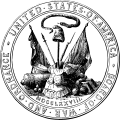Related Research Articles

The Second Battle of Bull Run or Battle of Second Manassas was fought August 28–30, 1862, in Prince William County, Virginia, as part of the American Civil War. It was the culmination of the Northern Virginia Campaign waged by Confederate Gen. Robert E. Lee's Army of Northern Virginia against Union Maj. Gen. John Pope's Army of Virginia, and a battle of much larger scale and numbers than the First Battle of Bull Run fought on July 21, 1861, on the same ground.

The Battle of Pea Ridge, also known as the Battle of Elkhorn Tavern, took place during the American Civil War near Leetown, northeast of Fayetteville, Arkansas. Federal forces, led by Brig. Gen. Samuel R. Curtis, moved south from central Missouri, driving Confederate forces into northwestern Arkansas. Maj. Gen. Earl Van Dorn had launched a Confederate counteroffensive, hoping to recapture northern Arkansas and Missouri. Confederate forces met at Bentonville and became the most substantial Rebel force, by way of guns and men, to assemble in the Trans-Mississippi. Against the odds, Curtis held off the Confederate attack on the first day and drove Van Dorn's force off the battlefield on the second. By defeating the Confederates, the Union forces established Federal control of most of Missouri and northern Arkansas.
The Battle of Cotton Plant also known as Action at Hill's Plantation or Action at Cache River or Action at Round Hill was fought during the American Civil War in Woodruff County, Arkansas. Frustrated in its attempt to march to Little Rock by a lack of supplies, the Union Army of the Southwest under the command of Samuel Ryan Curtis moved south down the White River. Curtis's army encountered a Confederate force led by Albert Rust on the east bank of the Cache River near Cotton Plant. Rust was only able to bring two Texas cavalry regiments into action. These horsemen attacked the Federal advance guard under Charles Edward Hovey, but after a spirited fight, Union reinforcements arrived and drove off the Texans. Rust's force made a disorderly retreat and Curtis's army was able to march south to Clarendon before veering east to occupy Helena on the Mississippi River.
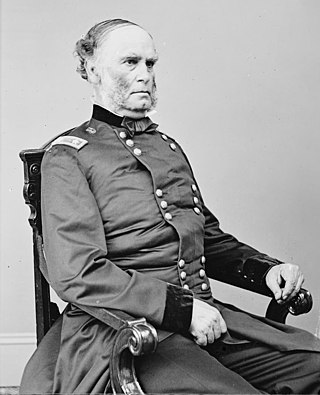
Samuel Ryan Curtis was an American military officer and one of the first Republicans elected to Congress. He was most famous for his role as a Union Army general in the Trans-Mississippi Theater of the American Civil War, especially for his victories at the Battles of Pea Ridge in 1862 and Westport in 1864.

The Battle of Wilson's Creek, also known as the Battle of Oak Hills, was the first major battle of the Trans-Mississippi Theater of the American Civil War. It was fought on August 10, 1861, near Springfield, Missouri.

The XI Corps was a corps of the U.S. Army during the American Civil War, best remembered for its involvement in the battles of Chancellorsville and Gettysburg in 1863. The corps was composed primarily of German-American regiments.
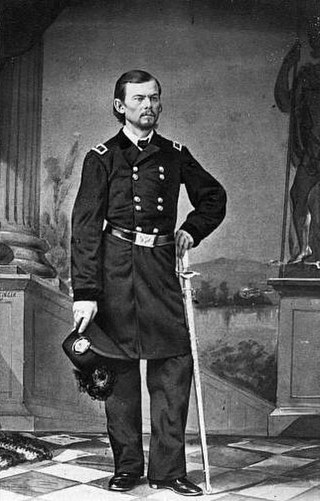
Franz Sigel was a German American military officer, revolutionary and immigrant to the United States who was a teacher, newspaperman, politician, and served as a Union major general in the American Civil War. His ability to recruit German-speaking immigrants to the Union armies received the approval of President Abraham Lincoln, but he was strongly disliked by General-in-Chief Henry Halleck.

The XVI Army Corps was a corps of the Union Army during the American Civil War. The corps rarely fought as a single unit, as its divisions were often scattered across the country.

The Army of the West, also known as the Trans-Mississippi District, was a formation of the Confederate States Army during the American Civil War that was a part of the Army of Mississippi. It saw action in the Battle of Pea Ridge, Battle of Corinth, and Battle of Iuka and consisted of about 20,000 personnel.
The trans-Mississippi theater of the American Civil War was the scene of the major military operations west of the Mississippi River. The area is often thought of as excluding the states and territories bordering the Pacific Ocean, which formed the Pacific coast theater of the American Civil War (1861–1865).
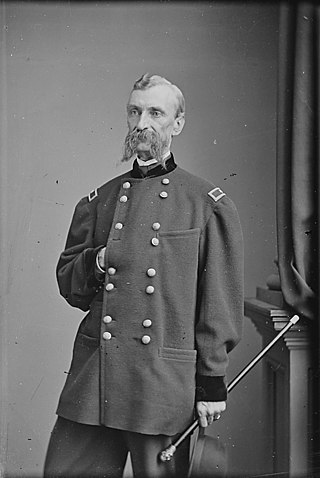
Alexander "Sandor" Asboth was a Hungarian military leader best known for his victories as a Union general during the American Civil War. He also served as United States Ambassador to Argentina and as United States Ambassador to Uruguay.
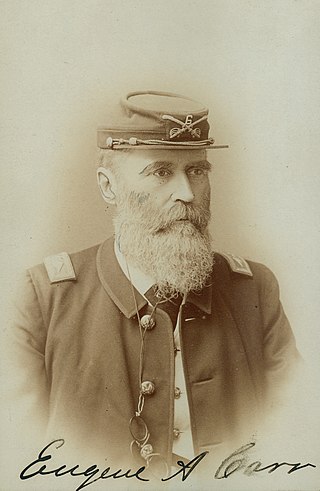
Eugene Asa Niel Carr was a soldier in the United States Army and a general in the Union Army during the American Civil War. He was awarded the Medal of Honor for his actions at the Battle of Pea Ridge.

Walker's Greyhounds was the popular name for a division of the Confederate States Army under Major-General John George Walker, composed exclusively of units from Texas. It fought in the Western Theater and the Trans-Mississippi Department, gaining its nickname because the men were able to move long distances rapidly on foot.
The 2nd Missouri Infantry Regiment was an infantry regiment, formed from a voluntary regiment using the same name, that served in the Union Army during the American Civil War.
Frederick Schaefer was a German revolutionary and Union Army colonel during the American Civil War. He was a brigade commander at the battles of Pea Ridge and Stones River where he was killed in action.

The 3rd Missouri Infantry Regiment was an infantry regiment that served in the Union Army during the American Civil War. It arose from a group of volunteers who were active from April to September 1861.
The Military Division of the Missouri was an administrative formation of the United States Army that functioned through the end of the American Civil War and the Indian Wars that continued after its conclusion. It was created by the War Department on February 3, 1865, at the direction of General Ulysses S. Grant to bring all the military departments west of the Mississippi River under a single commander.
The Department of the Northwest was an U.S. Army Department created on September 6, 1862, to put down the Sioux uprising in Minnesota. Major General John Pope was made commander of the Department. At the end of the Civil War the Department was redesignated the Department of Dakota.

Battery B, 1st Missouri Light Artillery Regiment, also known as Welfley's Independent Missouri Battery, was an artillery battery that served in the Union Army during the American Civil War. Organized in September 1861, Welfley's Independent Battery fought at Pea Ridge and in the White River campaign. After its name changed to Battery B, 1st Missouri in December 1862, it fought at Cape Girardeau, Chalk Bluff, Vicksburg, Sterling's Plantation, and Brownsville. In September 1864, the unit ceased to exist when it was consolidated with three other Missouri batteries while stationed at New Orleans.
Clark's Missouri Battery was an artillery battery that served in the Confederate States Army during the American Civil War.
